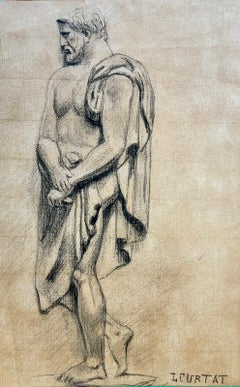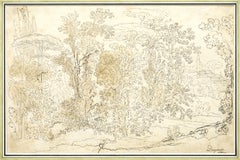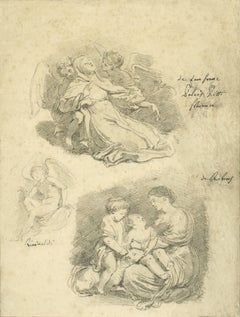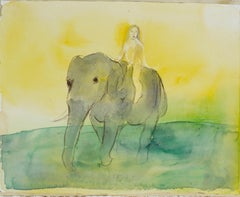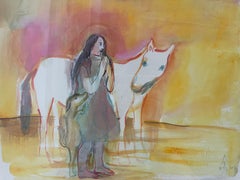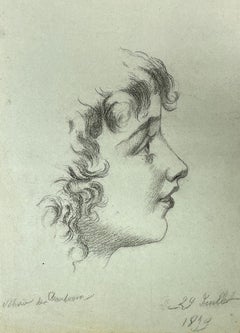Pencil Paintings
to
10
4
1
5
5
8
2
Overall Height
to
Overall Width
to
905
903
96
78
75
74
38
34
33
31
15
10
8
3
8
4
3
3
3
3
2
1
1
1
1
1
1
1
1
6
2
2
2
5
2
1
1
11,914
1,217
1,173
461
460
Style: Old Masters
Medium: Pencil
18th Century Italian Old Master Drawing Nude Figure Sketches Male & Female
Located in Cirencester, Gloucestershire
Figurative Sketches
Italian School, mid 18th century
circle of Pompeo Batoni (1707-1787)
charcoal and pencil, heightened with white chalk, unframed...
Category
Mid-18th Century Old Masters Pencil Paintings
Materials
Charcoal, Pencil, Chalk
A landscape drawing by Claude Lorrain, with a preliminary sketch on the verso
Located in PARIS, FR
This study presents a typical Roman countryside landscape: an ancient mausoleum in front of which a cart is passing by followed by two peasants. If the technique (a pen drawing on graphite lines, completed with a wash of brown and grey inks) and the signature inevitably evoke the art of Lorrain, we find on the verso of this drawing additional evidences that lead us to consider this unpublished drawing as a work by the master.
The motif of the mausoleum has been taken up in pen on the verso in a technique that can be found in several other drawings by Lorrain. There is also a study of three characters, which can be considered as preparatory to Lorrain’s painting entitled The Port of Ostia with the Embarkation of Saint Paula, leading us to claim this attribution with a dating of around 1629.
1. Claude Lorrain or the perfection of classical landscape in Rome in the 17th century
Claude Gellée was born in 1600 in Chamagne in Lorraine. Orphaned at the age of twelve, he spent a year with his brother in Freiburg, where the latter was a woodcarver. Claude Gellée then probably arrived in Rome in 1613, where he joined the workshop of Agostino Tassi (1580 - 1644) in 1617. Between 1619 and 1620 he studied for two years in Naples in the workshop of Goffredi Wals (who was himself a former pupil of Tassi).
In 1625 he returned to Lorraine for two years where he worked alongside Claude Deruet. He then returned to Rome, a city he never left for the rest of his life (except for short trips to the surrounding countryside).
From 1627 to 1650 he lived in Via Margutta. From 1635 onwards he became a renowned painter and commissions started to pour in. Considered during his lifetime as the most accomplished of the classical landscape painters, his reputation never faded.
Between 1629 and 1635 Le Lorrain often went to the Roman countryside to draw with his friend Joachim von Sandrart (1606 - 1686). He became a member of the Academy of Saint Luke in 1633, while being closely acquainted with the Bentvueghels, this guild which brought together the young Nordic painters active in Rome. In 1643 he joined the Congregation of the Virtuosi. In 1650 he moved to Via Paolina where he lived until his death.
Little is known of his intimate life. He seems to have had a daughter, Agnes, from an ancillary love affair. In 1657/ 1658 she moved in with him. Stricken with gout in 1663, he died in 1682.
2. Description of the drawing; the technique of nature studies
Two peasants are walking behind a horse-drawn cart on a road that winds through ancient tombs. While a rectangular tomb with a columned facade can be seen in the distance, the cart passes an important ancient building. It has a circular shape and its partially ruined façade is decorated with columns. The start of a second floor can...
Category
1660s Old Masters Pencil Paintings
Materials
Ink, Pen, Graphite
Fine 18th Century French Old Master Ink Wash Drawing Cain & Abel Fighting
Located in Cirencester, Gloucestershire
'Cain et Abel'
Circle of Franois Devosge
(1732-1811) French
pencil drawing with watercolour wash on paper
size: 12.25 x 9 inches
private collection, France
The painting is in overall...
Category
18th Century Old Masters Pencil Paintings
Materials
Washi Paper, Color Pencil
Classical Roman Nude Man draped in Robes, signed French drawing
Located in Cirencester, Gloucestershire
The Roman Man
French artist, 19th century
pencil drawing on paper, unframed
13 x 11 inches
private collection, France
the painting is in overall good and sound condition - very frag...
Category
19th Century Old Masters Pencil Paintings
Materials
Pencil
Italian Landscape, a drawing by Louis-Jean Desprez (1743 - 1804)
Located in PARIS, FR
This landscape, masterfully executed in pen and wash by Louis-Jean Desprez around 1779, probably represents a view of the Roman countryside. The treatment of the trees is very similar to that of two engravings which Desprez executed in Rome, The Island of Cythera and The Temple of Love.
1. Louis-Jean Desprez, a cosmopolitan life between Italy and Sweden
Born in Auxerre in 1743, Louis-Jean Desprez probably began his apprenticeship with the engraver Charles-Nicolas Cochin...
Category
1770s Old Masters Pencil Paintings
Materials
Carbon Pencil, Ink
Three studies executed in the Pitti Palace in 1761 by Jean-Honoré Fragonard
Located in PARIS, FR
This brilliant study sheet, of which we present here a counterproof, is a souvenir of Fragonard's return journey from Italy. Between April and September 1761, he accompanied the abbot of Saint-Non on his way back to France. Three studies after the masters taken from the Pitti Palace’s gallery in Florence are gathered on this sheet. Although The Ecstasy of Saint Margaret...
Category
1760s Old Masters Pencil Paintings
Materials
Carbon Pencil
18th C Italian Classical Grand Tour Ancient City Old Ruins & Figures
Located in Cirencester, Gloucestershire
Title: The Italian City
Artist/ School: English/ Italian School, late 18th century; a Grand Tour work.
Medium: pencil drawing.
Size: 6.75 x 9.75 inches
Provenance: from a priva...
Category
Late 18th Century Old Masters Pencil Paintings
Materials
Pencil
Fine Early 19th Century Classical Horse Study
Located in Cirencester, Gloucestershire
Title: Portrait of a Horse
Artist/ School: French School, circle of Jacques-Laurent Agasse (French 1767-1849)
Medium: pencil drawing on paper laid over card
Size: 10.25 x 11.5 inc...
Category
Early 19th Century Old Masters Pencil Paintings
Materials
Pencil
DRAWING OF A NACKED MAN ON LADDER
Located in Napoli, IT
DRAWING OF A NACKED MAN ON LADDER - - by Gennaro Luciano, 1920, with ebony frame. Cm.65x48
Category
1920s Old Masters Pencil Paintings
Materials
Pencil, Paper
DRAWING OF NAKED MAN
Located in Napoli, IT
DRAWING OF NAKED MAN - Study of light by Gennaro Luciano, Naples, 1920, with ebony frame. Cm.65x48.
Category
1920s Old Masters Pencil Paintings
Materials
Pencil, Paper
Related Items
Expressionist Figurative water color painting- Luckiness
Located in Beijing, CN
Expressionist Figurative water color painting by Zhang Chunyang
Title: Luckiness
Dimension: 29 x 36 cm
Material: Gouache, Watercolor on Paper
D...
Category
2010s Expressionist Pencil Paintings
Materials
Watercolor, Gouache, Handmade Paper
Free Shipping
H 11.42 in W 14.18 in
Expressionist Figurative water color painting- Series The Horse Whisper No.2-25
Located in Beijing, CN
Expressionist Figurative water color painting by Zhang Chunyang
Series The Horse Whisper No.2-25
Dimension: 29 x 36 cm
Material: Gouache, Watercolor on Paper
Date: 2013
Artist B...
Category
2010s Expressionist Pencil Paintings
Materials
Watercolor, Gouache, Handmade Paper
Zhang ChunyangExpressionist Figurative water color painting- Series The Horse Whisper No.2-25 , 2013
Free Shipping
H 11.42 in W 14.18 in
Nudo maschile nella posa di un satiro dormiente. XIX secolo
Located in Firenze, IT
Disegno del nudo maschile.
Dal 19 ° secolo
Disegno su carta leggermente colorata.
In buone condizioni.
Il disegno rappresenta un uomo sdraiato, che si abbandona al sonno.
In una posa...
Category
19th Century Academic Pencil Paintings
Materials
Paper, Carbon Pencil
Free Shipping
H 13.39 in W 18.51 in D 0.04 in
The Abduction of the Sabine Women , a Renaissance drawing by Biagio Pupini
Located in PARIS, FR
This vigorous drawing has long been attributed to Polidoro da Caravaggio: The Abduction of the Sabine Women is one of the scenes that Polidoro depicted between 1525 and 1527 on the façade of the Milesi Palazzo in Rome. However, the proximity to another drawing inspired by this same façade, kept at the Ecole des Beaux-Arts, and to other drawings inspired by Polidoro kept at the Musée du Louvre, leads us to propose an attribution to Biagio Pupini, a Bolognese artist whose life remains barely known, despite the abundant number of drawings attributed to him.
1. Biagio Pupini, a Bolognese artist in the light of the Roman Renaissance
The early life of Biagio Pupini, an important figure of the first half of the Cinquecento in Bologna - Vasari mentions him several times - is still poorly known. Neither his date of birth (probably around 1490-1495) nor his training are known. He is said to have been a pupil of Francesco Francia (1450 - 1517) and his name appears for the first time in 1511 in a contract with the painter Bagnacavallo (c. 1484 - 1542) for the frescoes of a church in Faenza. He then collaborated with Girolamo da Carpi, at San Michele in Bosco and at the villa of Belriguardo.
He must have gone to Rome for the first time with Bagnacavallo between 1511 and 1519. There he discovered the art of Raphael, with whom he might have worked, and that of Polidoro da Caravaggio. This first visit, and those that followed, were the occasion for an intense study of ancient and modern art, as illustrated by his abundant graphic production.
Polidoro da Caravaggio had a particular influence on the technique adopted by Pupini. Executed on coloured paper, his drawings generally combine pen, brown ink and wash with abundant highlights of white gouache, as in the drawing presented here.
2. The Abduction of the Sabine Women
Our drawing is an adaptation of a fresco painted between 1525 and 1527 by Polidoro da Caravaggio on the façade of the Milesi Palace in Rome. These painted façades were very famous from the moment they were painted and inspired many artists during their stay in Rome. These frescoes are now very deteriorated and difficult to see, as the palace is in a rather narrow street.
The episode of the abduction of the Sabine women (which appears in the centre of the photo above) is a historical theme that goes back to the origins of Rome and is recounted both by Titus Livius (Ab Urbe condita I,13), by Ovid (Fasti III, 199-228) and by Plutarch (II, Romulus 14-19). After killing his twin brother Romus, Romulus populates the city of Rome by opening it up to refugees and brigands and finds himself with an excess of men. Because of their reputation, none of the inhabitants of the neighbouring cities want to give them their daughters in marriage. The Romans then decide to invite their Sabine neighbours to a great feast during which they slaughter the Sabines and kidnap their daughters.
The engraving made by Giovanni Battista Gallestruzzi (1618 - 1677) around 1656-1658 gives us a good understanding of the Polidoro fresco, allowing us to see how Biagio Pupini reworked the scene to extract this dynamic group.
With a remarkable economy of means, Biagio Pupini takes over the left-hand side of the fresco and depicts in a very dense space two main groups, each consisting of a Roman and a Sabine, completed by a group of three soldiers in the background (which seems to differ quite significantly from Polidoro's composition).
The balance of the drawing is based on a very strongly structured composition. The drawing is organised around a median vertical axis, which runs along both the elbow of the kidnapped Sabine on the left and the foot of her captor, and the two main diagonals, reinforced by four secondary diagonals. This diamond-shaped structure creates an extremely dynamic space, in which centripetal movements (the legs of the Sabine on the right, the arm of the soldier on the back at the top right) and centrifugal movements (the arm of the kidnapper on the left and the legs of the Sabine he is carrying away, the arm of the Sabine on the right) oppose each other, giving the drawing the appearance of a whirlpool around a central point of support situated slightly to the left of the navel of the kidnapper on the right.
3. Polidoro da Caravaggio, and the decorations of Roman palaces
Polidoro da Caravaggio was a paradoxical artist who entered Raphael's (1483 - 1520) workshop at a very young age, when he oversaw the Lodges in the Vatican. Most of his Roman work, which was the peak of his career, has disappeared, as he specialised in facade painting, and yet these paintings, which are eminently visible in urban spaces, have influenced generations of artists who copied them abundantly during their visits to Rome.
Polidoro Caldara was born in Caravaggio around 1495-1500 (the birthplace of Michelangelo Merisi, known as Caravaggio, who was born there in 1571), some forty kilometres east of Milan. According to Vasari, he arrived as a mason on the Vatican's construction site and joined Raphael's workshop around 1517 (at the age of eighteen according to Vasari). This integration would have allowed Polidoro to work not only on the frescoes of the Lodges, but also on some of the frescoes of the Chambers, as well as on the flat of Cardinal Bibiena in the Vatican.
After Raphael's death in 1520, Polidoro worked first with Perin del Vaga before joining forces with Maturino of Florence (1490 - 1528), whom he had also known in Raphael's workshop. Together they specialised in the painting of palace façades. They were to produce some forty façades decorated with grisaille paintings imitating antique bas-reliefs.
The Sack of Rome in 1527, during which his friend Maturino was killed, led Polidoro to flee first to Naples (where he had already stayed in 1523), then to Messina. It was while he was preparing his return to the peninsula that he was murdered by one of his assistants, Tonno Calabrese, in 1543.
In his Vite, Vasari celebrated Polidoro as the greatest façade decorator of his time, noting that "there is no flat, palace, garden or villa in Rome that does not contain a work by Polidoro". Polidoro's facade decorations, most of which have disappeared as they were displayed in the open air, constitute the most important lost chapter of Roman art of the Cinquecento. The few surviving drawings of the painter can, however, give an idea of the original appearance of his murals and show that he was an artist of remarkable and highly original genius.
4. The façade of the Milesi Palace
Giovanni Antonio Milesi, who commissioned this palace, located not far from the Tiber, north of Piazza Navona, was a native of the Bergamo area, like Polidoro, with whom he maintained close friendly ties. Executed in the last years before the Sack of Rome, around 1526-1527, the decoration of Palazzo Milesi is considered Polidoro's greatest decorative success.
An engraving by Ernesto Maccari made at the end of the nineteenth century allows us to understand the general balance of this façade, which was still well preserved at the time. The frescoes were not entirely monochrome, but alternated elements in chiaroscuro simulating marble bas-reliefs and those in ochre simulating bronze and gold vases...
Category
16th Century Old Masters Pencil Paintings
Materials
Ink, Gouache, Pen
Preparatory anatomical study for the figure of a man with hands on his face.
Located in Firenze, IT
Preparatory anatomical study for the figure of a man with hands on his face.
Drawing of a medium-sized male nude.
From the 19th century
Drawing on slightly greyish colored paper.
In ...
Category
Late 19th Century Academic Pencil Paintings
Materials
Gesso, Paper, Charcoal, Carbon Pencil
Free Shipping
H 17.72 in W 13.39 in
Fine 1700's Italian Old Master Ink & Wash Drawing Roman Allegorical Insubria
Located in Cirencester, Gloucestershire
'Insubria'
Italian School, 18th century
ink and wash drawing on paper, framed within a light oak wood frame (behind glass)
image size: 10.5 x 7 inches
overall framed: 17 x 13 inches
...
Category
18th Century Old Masters Pencil Paintings
Materials
Watercolor, Ink, Archival Paper
"New England Landscape with Barns, " Andrew Nathaniel Wyeth, American Art
Located in New York, NY
Andrew Nathaniel Wyeth (American, b. 1948)
New England Landscape with Barns, 1974
Watercolor and pencil on Bainbridge watercolor board
20 x 30 i...
Category
1970s Pencil Paintings
Materials
Watercolor, Board, Pencil
Follower of Francesco Guardi, Figures in a Mediterranean port by a Roman Arch
By Francesco Guardi
Located in Harkstead, GB
A lively, well executed sketch painted by a 19th century follower of Francesco Guardi
Follower of Francesco Guardi, 19th Century
Figures by a Roman Arch
Watercolour with ink and sc...
Category
19th Century Old Masters Pencil Paintings
Materials
Paper, Ink, Watercolor
Free Shipping
H 6.5 in W 5 in D 1 in
Purple Cypress Tree - Coastal Fauvist Vertical Landscape
By Karen Druker
Located in Soquel, CA
Brightly colored Fauvist coastal landscape of a vivid purple cypress tree at the edge of the water, under a bright yellow sky and orange sun by Karen Druker (American, 1945). Signed ...
Category
21st Century and Contemporary Fauvist Pencil Paintings
Materials
Paper, Pastel, Watercolor, Pencil
H 36 in W 28 in D 0.13 in
Study, preparatory work for “La Princesse”, watercolor and pencil on paper
Located in PARIS, FR
Raphael DELORME (1886-1962)
Study, preparatory work for “La Princesse”
Watercolor and pencil on paper
Annotated “La Princesse”
30,5 x 22,5 cm
Small folds and small stains
Born in 18...
Category
1930s Art Deco Pencil Paintings
Materials
Watercolor, Pencil
Study, preparatory work for “La Princesse”, watercolor and pencil on paper
Located in PARIS, FR
Raphael DELORME (1886-1962)
Study, preparatory work for “La Princesse”
Watercolor and pencil on paper
Annotated “La Princesse”
30,5 x 22,5 cm
Small folds and small stains
Born in 18...
Category
1930s Art Deco Pencil Paintings
Materials
Pencil, Watercolor
Philosophers Garden - Modern Nature Oil Pastel Painting, Conceptual Art
By Janusz Kokot
Located in Salzburg, AT
Janusz Kokot was born in Kalisz in 1960. He studied at the Pedagogical University in Częstochowa at the Art Institute. He practices painting and drawing. In the years 1988 - 2020 he ...
Category
2010s Contemporary Pencil Paintings
Materials
Paper, Oil Pastel, Pen
Previously Available Items
Bacchus Classical Mythology Old Master Drawing Semi Nude Man, Dog & Grapes
Located in Cirencester, Gloucestershire
Bacchanalian Man, holding vine stump with dog
Circa 1800’s
French artist, signed Richard
Pencil drawing on paper, unframed
13 x 11 inches
private collection, France
the painting is i...
Category
Early 19th Century Old Masters Pencil Paintings
Materials
Pencil
H 13 in W 11 in D 1 in
Early 1800's French Portrait of Young Child, Signed & Dated on blue paper
Located in Cirencester, Gloucestershire
Head Study of a Child
French School, early 19th century
indistinctly signed and dated 1819.
pencil drawing on blue paper, unframed
size: 10 x 7.75 inches
condition: overall good for...
Category
Early 19th Century Old Masters Pencil Paintings
Materials
Pencil
FINE 18th CENTURY OLD MASTER CHARCOAL DRAWING - THE LAMENTATION OF CHRIST
Located in Cirencester, Gloucestershire
Artist/ School: French School, 18th century
Title: The Lamentation.
Medium: charcoal on paper, mounted.
Size: drawing: 13 x 15.5 inches
Provenance: private collection,...
Category
Mid-18th Century Old Masters Pencil Paintings
Materials
Charcoal, Pencil
Fine 1840's Grand Tour Drawing Ancient Italian Ruins Roman Columns Landscape
Located in Cirencester, Gloucestershire
Title: Roman Ruins, most likely a Grand Tour drawing.
Artist/ School: English School, indistinctly inscribed and dated 1841.
Medium: pencil drawing on card.
Size: 8.75 x 11 inch...
Category
Early 19th Century Old Masters Pencil Paintings
Materials
Pencil
Classical Roman Ruins, c. 1840 drawing
Located in Cirencester, Gloucestershire
Roman Ruins
English School, circa 1840
pencil drawing with watercolour wash on paper
unframed but mounted
image: 5 x 7 inches
framed: 12 x 13.25 inches
provenance: private collection, London
Finely executed drawing, with a watercolour wash, depicting this Grand Tour subject of travellers in a landscape...
Category
Mid-19th Century Old Masters Pencil Paintings
Materials
Paper, Watercolor, Carbon Pencil
18th Century Frieze or Ceiling Design Original Pencil Drawing Bacchus
Located in Cirencester, Gloucestershire
Bacchus
Italian School, early 1700's
pencil drawing, framed and glazed
image: 13 x 8 inches
framed: 20 x 14.75 inches
Superb quality, very rare early 1700's Italian Old Master drawing depicting a male nude of muscular physique. The work is most likely a preparatory design for a frieze or possibly a ceiling design...
Category
Early 18th Century Old Masters Pencil Paintings
Materials
Pencil
H 20 in W 14.75 in D 0.5 in
DRAWING OF NAKED MEN
Located in Napoli, IT
DRAWING OF NAKED MEN - Gennaro Luciano Italia 1920 - Drawing of naked man cm.65x48, with ebony frame.
Category
1920s Old Masters Pencil Paintings
Materials
Paper, Pencil
Pencil paintings for sale on 1stDibs.
Find a wide variety of authentic Pencil paintings available on 1stDibs. While artists have worked in this medium across a range of time periods, art made with this material during the 21st Century is especially popular. If you’re looking to add paintings created with this material to introduce a provocative pop of color and texture to an otherwise neutral space in your home, the works available on 1stDibs include elements of blue, orange, pink, red and other colors. There are many well-known artists whose body of work includes ceramic sculptures. Popular artists on 1stDibs associated with pieces like this include Andrea Stajan-Ferkul, Howard Tangye, Jaanika Peerna, and Jenny Day. Frequently made by artists working in the Contemporary, Abstract, all of these pieces for sale are unique and many will draw the attention of guests in your home. Not every interior allows for large Pencil paintings, so small editions measuring 0.1 inches across are also available
Recently Viewed
View AllMore Ways To Browse
Italian Battle
19th Century Large French Oil Painting
New French Tapestry
Town Plan
Field Watch
Brother Record
Retro Style Picture Frames
Large Matisse Paintings
Russian Dancers
Neon Large
Antique Paintings Of People
St John Set
Fire Dancing
Used American Dolls
Oil Painting 1840
Vintage Portrait Painting
Letter E
Small Cubist



